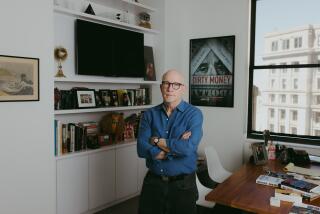Phil Spector’s wall remains unbreached
EVEN before that horrifying predawn moment four years ago in his Alhambra castle, Phil Spector was widely viewed in the music industry as something of a freak show.
Lana Clarkson’s death was, in many ways, the tragic public climax of years of wildly eccentric, sometimes alarming behavior by the man who produced landmark recordings by John Lennon, the Righteous Brothers and the Ronettes.
During a series of all-night conversations I had with Spector in the ‘70s and in the early ‘90s, the man Tom Wolfe dubbed the “first tycoon of teen” spoke often about Lenny Bruce, his friend and hero whose savage social commentary helped redefine comedy in America. What haunted Spector was that this “brilliant man” would be most remembered as a junkie who died on a bathroom floor with a hypodermic needle stuck in his arm.
Now, regardless of the verdict in the trial over Clarkson’s murder, Spector faces a similar, scandal-driven legacy, one forever linked to the morning of Feb. 3, 2003, when a gun was placed in Clarkson’s mouth and the trigger was pulled.
In his new book, “Tearing Down the Wall of Sound,” British journalist Mick Brown chronicles the rise and fall of Spector. Not surprisingly, most of this well-researched but disappointingly timid volume deals with the painful descent of this breathtakingly original music man.
For the book, Brown interviewed more than 100 people, including Spector in a doozy of an encounter just weeks before Clarkson’s death. In their four-hour session at the Alhambra house, the author confronted Spector about the rumors of personal problems, including the possessiveness, paranoia and periods of excessive drinking.
Spector replied that he had not been well for years. “I was crippled inside. Emotionally,” he told Brown. “Insane is a hard word.... I take medication for schizophrenia, but I wouldn’t say I’m schizophrenic. But I have a bipolar personality.... I have devils inside that fight me. And I’m my own worst enemy.”
The words were striking enough when they appeared in Brown’s profile of the producer for London’s Daily Telegraph magazine on Feb. 1, 2003. They became even more riveting just days later when the gun went off in Spector’s house. Brown devotes a chapter near the end of the book to that interview, yet the heart of his work rests with what other people told him.
Things didn’t start off well for Harvey Philip Spector, who was born the day after Christmas in 1939 in the Bronx. He was still in grade school when his father committed suicide, leaving Spector’s mother with such a deep sense of family shame that she moved with Phil and his sister, Shirley, to Los Angeles.
The teenage Spector, who was also traumatized by his father’s death, found it difficult to make friends at Fairfax High School. Discovering joy in music, he plotted a career in the record business, first as an artist and songwriter, but eventually as a producer. His first hit with a trio called the Teddy Bears came the summer after graduation. Spector adapted the title of the light 1958 pop ballad from the epitaph on his father’s tombstone: “To Know Him Is to Love Him.”
Massively ambitious, Spector launched his own label, Philles, in 1961, and although the hits carried the names of such artists as the Crystals and the Ronettes, the star of those records was Spector himself.
His R&B-flavored; pop singles, including “He’s a Rebel” and “Da Doo Ron Ron,” were built around a sweeping, even audacious vision -- tales about youthful desires and doubts so overflowing with emotion that it took an army of musicians to capture all the passion. It was dubbed Spector’s “Wall of Sound.” Indeed, few records in pop history have conveyed the exhilaration of love’s arrival as much as “Be My Baby” or the despair of its loss as “You’ve Lost That Lovin’ Feelin’.”
Despite being called a genius and a visionary, Spector was a bundle of insecurities and contradictions, especially after the hits stopped coming in the mid-’60s, when the Beatles and Bob Dylan turned the music world upside down. Spector made periodic comeback attempts, but they were short-lived. His last real taste of glory was co-producing John Lennon’s “Imagine” album more than 35 years ago.
Several of Spector’s friends and associates spoke to Brown at length about the producer’s conflicting traits (generous, yet controlling; charming, but spiteful; sweet, though a touch mad).
The pop auteur’s first wife, Annette Merar, recalling his vulnerability, told of him seeking reassurance in a late-night phone call in the ‘60s after they were separated. “It would be: ‘Okay, the Beatles are number one, and the Stones are number two, but am I before Bob Dylan or after Bob Dylan?’ ” she said. “And I’d say, ‘No, you’re definitely number three and Dylan’s number four’ -- even though I didn’t really think so.”
Reports of reclusive, unconventional behavior and sometimes smothering jealousy go back to the “To Know Him” days. An early girlfriend, Lynn Castle, said his constant possessiveness drove her away. “Where are you? What are you doing? What are you thinking? Where are you going? Controlling,” she said. “I remember saying to Phil, I can’t stand it anymore, because I just felt like I was choking.”
Variations on that theme -- and others, including Spector’s often desperate need for company late at night -- echo throughout the book as Brown focuses on the producer’s personal life far more than his music. The unstated goal seems to be to try to understand what led to the shooting in Alhambra.
The problem with Brown’s book is twofold. First, the story becomes tiresome as various people tell essentially the same story again and again of the lonely, troubled, bipolar “Howard Hughes of rock.” But also, Mark Ribowsky in the 1989 book “He’s a Rebel” beat Brown to most of the crucial Spector history. (An updated edition of Ribowsky’s book has been released recently in paperback by Da Capo. They talked to so many of the same sources that it’s amusing to imagine a source having Brown on hold while talking to Ribowsky on the other line. They could even have shared cab rides.)
Rather than keep rehashing the details of Spector’s life and musical career, someone needs to go beyond the research the way, say, Nick Tosches did in his superb biographies of Dean Martin and Jerry Lee Lewis. Tosches learned everything he could about his subjects, then took leaps of faith to assemble psychological profiles that made us feel like we could see the world through their eyes.
Nik Cohn, an excellent British writer, brought us closest to Spector in a compelling profile printed some 30 years ago in “The Rolling Stone Illustrated History of Rock & Roll.” Cohn abandoned plans to write a biography of Spector after spending time with him, deciding that Spector’s vision had left him and all that remained were the “motions of mystique.” The biography, he feared, would read like an obituary.
Brown interviewed Cohn and even quotes from the latter’s profile of Spector: “It seemed that he had no more great pleasures, no passions, not even all-consuming hatreds. Sometimes he would say he was happy, and he smiled. At other times he shook his head and looked tragic. But mostly he simply sat, and survived, and let time pass.”
That passage of Cohn’s is by far the most powerful single image in “Tearing Down the Wall of Sound,” one that reminds us of how little Brown was able to penetrate the wall surrounding the inner Spector.
When I asked Spector in a 1991 interview if he had any regrets, he said, “Sure, lots of them ... from people I married to records I could have done. I have a lifetime of regrets. I should have gone on a lecture circuit. I should have done something to teach, to talk to people about the music.... I should have not wasted all those years.
“Eventually, [being] reclusive becomes an addiction. I never went to the store for years ... never went out, never did anything. It’s safer hiding away because you don’t have to commit yourself to anything. It’s a [shield] just like the drugs or the drink; only it’s much more painful because you are alive and well and you see everything around you.”
Spector is such a complex personality that not even his friends or foes, in all the conversations, were able to unlock the keys of his story for Brown. By simply relying on their words rather than supplying any authorial vision, Brown was doomed to failure. The reclusive tycoon remains a stranger.
Robert Hilburn, former pop music critic for The Times, is writing a pop music history.
More to Read
Sign up for our Book Club newsletter
Get the latest news, events and more from the Los Angeles Times Book Club, and help us get L.A. reading and talking.
You may occasionally receive promotional content from the Los Angeles Times.






